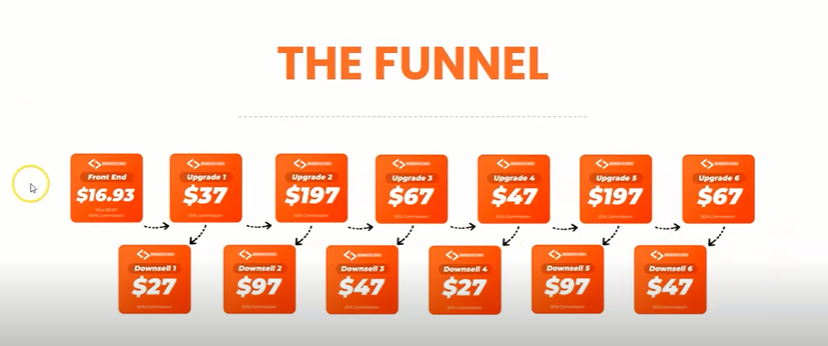This is a post I wish I didn’t have to write. But purveyors of b&llsh*t “easy-riches” training and get-rich-quick software infest the internet marketing and make-money-online marketplaces, and you need to know what to watch for and step away from.
Here are three tactics you must watch for:
- Understating the difficult of building a business with claims like “3 Easy Steps”
- Use of glitzy, flashy, irrelevant imagery
- Low front-end prices that disguise hidden limitations and deep, expensive upgrade sales funnels
Now let’s look at examples, so you’ll be on the alert when considering a training purchase:
Understating the Difficulty of Online Businesses
Promoters of get-rich-quick products often try to make it look easy by saying that using their product to build a business takes just “three easy steps.” A “three easy steps” list from a recent product promotion read:
1) Pick Any Niche. “Hell Yes!” says the promoter. “This works in ANY niche on demand.”
2) Add your monetization. “As simple as “pasting” your affiliate link,” they say. “So easy, and so awesome!”
3) Activate the free traffic. “Yes,” they assure us, “even the traffic is included…” “It’s all so EASY!”
Step 1: Pick Any Niche
Let’s examine Step 1, shall we?
Step 1: “Pick a niche.” In this case, it means that you get to paste in your Clickbank affiliate ID for five products. That gives you a very basic squeeze page that allows you collect prospects’ emails before sending them on to either a poorly-written pre-sell page or direct to the product creator’s sales page. Just five products come with these pre-built pages.
And the “any niche” promise? Not quite any niche, but quite a few–more than 600, actually. Quite a selection, you might think. Well, let’s say we go with the red-hot accordian niche.
Here’s the upper portion of the sales page you get to work with:

Ready to replace that lorem ipsum with your own mouth-watering accordian sales copy? Sounds like an extra step, doesn’t it? And changing the header image? Sorry, no can do. Leaves you wishing for another step, eh?
Leaving aside the low quality of the tools like these that are presented in many one-click wonder products, choosing a niche is something that calls for multiple research steps:
- Market validation (are enough people interested?)
- Audience demographic research
- Checking to ensure there are multiple products to promote
- Trends analysis (is the marketing growing, flat, or dying out?
- and more
So for starters, you pay to either use the original product sales page or to use grab a template (if it’s one of those offered) and then learn to write compelling sales copy on your own. So much for step 1, “pick a niche.”
Step 2: Add Your Monetization
Now let’s look at the affiliate programs and links you’ll need.
If you choose of the pre-selected niches products, the product seller almost achieves a “one-step step” here, I’ll give ‘em that. They say it takes no more that pasting in your affiliate link. How will you get it?
Visit Clickbank.com
Create your account.
Find the product in the marketplace.
Click Promote
Generate your affiliate link.
Add a tracking ID at the end (smart move)
Visit a link shortening service like bitly.com (Why? Raw Clickbank links look a bit cumbersome, and might discourage your prospective purchasers.)
Now, suppose you don’t chose one of those five niches? Well, let’s pick the good ol’ accordion niche again. Here would be likely steps:
Visit Clickbank, as above.
Find an accordion-related product.
Having found none: go to Google and search on “accordion affiliate program.”
Apply for the program. Unlike Clickbank, with its easy affiliate approval process, other merchants often require you to prove that you qualify to represent their brand. An introduction to one of them reads, “Are you passionate about music and have a fantastic website, app, social channel or blog?” Hint: the generic sales page made available to you above (remember its single anemic image in the header, placeholder headings, and lorem ipsum text everywhere else) will not get you approved. You’ve got lots of work ahead of you, building a web presence like the product owners will require of you.
There’s a more realistic look at step 2. The one they call “so easy and so awesome.” Now let’s see about that traffic, okay?
Built In Traffic
On the bright side (not so bright, really), we have some traffic options:

Hmmm… Which traffic source shall we use?
Gmail? Really? Will your Mom, brother, and friends welcome your link?
What about Evernote (the elephant icon)? Evernote, for driving traffic? Evernote’s a note-taking app, not a social network to use for traffic.
Hey, what about Instapaper (the Capital “I” icon)? Well, Instapaper lets you store online content—articles, and so on—in a convenient place for your later reading.
A couple of possibly-useful options are included. But let’s say you use Facebook or LinkedIn. Do you have followings there? Do you have a substantial presence on those platforms in the niche you’ve chosen?
If not, there’s a ton of work ahead of you, with many steps involved in creating an account the right way, creating compelling content, and establishing a following on the social platform of your choice.
The list of sub-steps involved in building such a social web presence goes far beyond the scope of this article.
Now, the product I chose for this example used only a few dubious traffic options. I’ve seen product sellers present as many as 100, the vast majority of them being equally dubious options for traffic generation.
The deeper point is this: If someone peddling a get-rich-quick software tries to bamboozle you into thinking Evernote is a viable traffic source for affiliate marketing, don’t think you can trust other aspects of their product. You can’t.
So much for our three easy steps. They each involve multiple sub-steps and numerous obstacles. So “easy” and so “awesome?” Not so much.
Use of Emotive But Irrelevant Graphics
Many BS product sellers use stock images that convey the agony people experience before they buy and the ecstasy that prospective buyers supposedly can look forward to. Images like these:


You’ll find yourself scrolling through page after page of images intended to get you intimidated at the thought of doing real business-building work, then get you excited at the prospect of easy-peasy money making success–success that will remain a fantasy if you continue buying products whose creators stoop to using such evocative images while failing to give you the details of the product they want you to buy.
Hidden Limitations and Deep Funnels
Almost all one-click riches products offer a low-priced front-end product with multiple upsells. And very often, the first upsell is to allow even a reasonable number of campaigns or searches or pages of whatever their software is supposed to provide.
Here’s the thing: why wasn’t anything said about the limitations on the front-end sales page?
Well, that wouldn’t lure you into the sales funnel very well, would it? You might actually ask them: “how many websites/sales pages/keyword searches/whatever do I get with the front end?” And if they revealed how few they offer, you’d walk away (good for you). Just as you would if you emailed them about it and they refused to answer.
Serial bullsh*t product sellers and frequent buyers of such products share a regrettable culture much like that of drug dealers and junkies. The buyers may hope they’re getting a bargain, but they don’t really believe they will. But they’re so addicted to the wish of easy riches that they just can’t help themselves.
And the sellers? They often make a matter-of-fact reason for the upsell: “let’s remove those limitations.” As if the limitations were understood and expected by any reasonable buyer.
As for brand newbies in the market: if they realized what a digital turd they paid for with the front-end transaction, they wouldn’t be drawn in by the chance to use the POS without limits.
Let’s put a picture to this practice; below is a funnel-diagram from a recent scammy product with a low-priced front-end offer. Notice how much you can end up spending if you get sucked in.

By offering a low up-front price, the sellers hope to entice inexperienced marketers into spending over $600.00, much of it for upsells that either won’t work any better than the lead-in offer, or that new marketers don’t have the skills to use anyway.
It’s almost inevitable that you’ll run into hucksters peddling garbage software and training, hoping to lure you in with BS promises of easy riches.
Watch out for sales tactics like these, and save your money for reliable software and quality training. Understand that there’s lots of work to be done, that pretty pictures don’t predict quality, and that you need to know up front whether you’re getting a comprehensive product or just a cheap taste with expensive upsell behind it.

